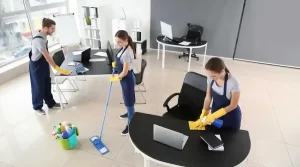The season of renewal is said to be spring. It’s a season when fresh buds appear, trees fill up, and the grass turns greener. Mother Nature is not the only culprit. Many of us have developed the practice of spring cleaning to refresh the areas we occupy.
The beginning of spring is a time of opportunity for facilities managers. The season is a terrific opportunity to improve the aesthetic of your facility, get ready for the warmer months ahead, and be proactive with maintenance, even if your building doesn’t have an official “spring cleaning” period.
Seven Considerations for Commercial Facility Spring Cleaning
Here are some important topics you might want to address as the spring draws closer to help you plan your agenda:
1. Landscape improvement: tidy up, clean up, and go green
Employees and visitors alike may form quite different opinions of your facilities as a result of your landscaping. Any building can look more inviting with a well-kept yard. Your landscaping needs a lot of work in the spring.
You should think about the following additional landscaping projects in the spring in addition to preparing for routine mowing and maintenance:
- putting down new mulch
- applying a pre-emergent herbicide or weeding
- seeding/overseeding and aeration
- clearing shrubs
- addressing any trouble spots
- new tree, shrub, or flower planting
2. Windows: Increase lighting in your space
Winter weather, whether severe or moderate, can make your building’s façade appear, well, aged. The majority of it typically affects structures with a lot of windows. You might not even be aware of how much natural light you’re losing as a result of the window film.
Cleaning all of your windows is similar to upgrading from SD to HD television. The atmosphere of everyone in your facility can improve when entire rooms become lighter. Make sure to clean all of your windows on the inside and out for the best results.
3. Carpet: Dig deep to undo the severe winter damage
The hardest season for facility carpets is typically winter. In the winter, moisture, mud, and debris attack carpets more frequently and embed themselves more deeply as a result of foot traffic such as stomping or wiping. It’s also possible for snow or salt to land on your carpet, further destroying its appearance and maybe inflicting long-term harm.
There is no more crucial time to get your industrial carpet professionally cleaned than the spring, as we can attest as a company that has been in the commercial carpet cleaning industry for two decades. It’s at this point that your facility’s carpets truly need to be thoroughly cleaned. Your carpet will look refreshed afterward, and it will also help the carpet last longer.
4. Upholstery: Refresh your workplace furnishings if necessary.
In the months after the winter, your upholstery also needs to be thoroughly cleaned. The furniture in your building is also affected by the extra filth and moisture that tends to enter throughout the winter, in addition to bacteria and dead skin cells.
Avoid the usual mistake of neglecting your facility’s furniture when spring cleaning. Whether your furniture is leather or upholstered, a professional cleaning will make it look younger and less dingy.
5. AC/HVAC: Get ready for the heat by setting up your system
It’s always a good idea to make sure your unit is operating at peak efficiency as you switch from heating to cooling your building. To ensure everything is in working order, test your equipment by running it for a time. Additionally, you should look for any issues that might arise because of aging hardware or degrading components.
Additionally, now is the perfect time to clean out all of your vents and ducts and remove dust from all of your unit’s rarely-cleaned crevices and crevices. When they do this, they often discover things like mold or pest infestations that are surprising. Regarding AC, it makes sense to take preventative measures now rather than risk a system failure on a sweltering July day.
6. Pest control: Prevent insects from crowding your establishment.
In the spring, the pest population also comes back to life. Pests, whether they be ants, termites, spiders, mosquitoes, or, gasp, bed bugs, maybe a major concern for business buildings. Buildings may be closed for days or even weeks as a result of severe infestations. The best way to do pest management is proactive, like most things in facility management.
Be aware of the bugs that are common in your area and have your building treated to keep those pesky critters out. Identify any outdoor elements, such as landscaping, standing water, food or rubbish, or tiny holes or access points in the building exterior, that may be luring pests if you had pest problems the spring or summer before.
7. Complete Facility Check: Prevent issues and organize your upcoming project
Every season’s beginning offers a chance to do a thorough facility walkthrough. Use this opportunity to assess the overall condition of your facility. Determine any potential problems before they occur. Think ahead as well, though.
Which machinery could use an upgrade? Where might the use of modern or intelligent technology be advantageous for your facility? What are some strategies you may use going the future to cut maintenance costs? Make a wish list for your facility. Make a note of these things even if you are unable to do any or all of them at the moment. Perhaps you could set a springtime goal to cross one thing off your list.





